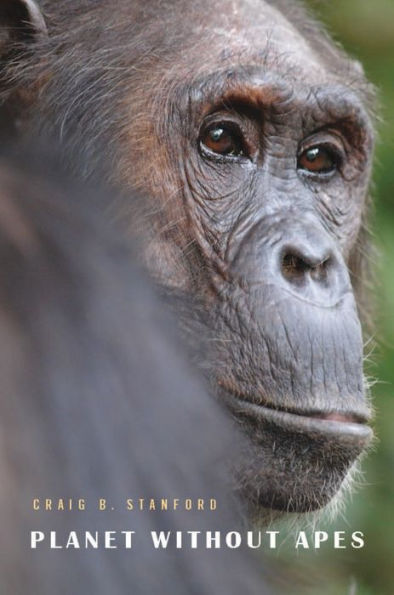

eBook
Available on Compatible NOOK devices, the free NOOK App and in My Digital Library.
Related collections and offers
Overview
Planet Without Apes demands that we consider whether we can live with the consequences of wiping our closest relatives off the face of the Earth. Leading primatologist Craig Stanford warns that extinction of the great apes—chimpanzees, bonobos, gorillas, and orangutans—threatens to become a reality within just a few human generations. We are on the verge of losing the last links to our evolutionary past, and to all the biological knowledge about ourselves that would die along with them. The crisis we face is tantamount to standing aside while our last extended family members vanish from the planet.
Stanford sees great apes as not only intelligent but also possessed of a culture: both toolmakers and social beings capable of passing cultural knowledge down through generations. Compelled by his field research to take up the cause of conservation, he is unequivocal about where responsibility for extinction of these species lies. Our extermination campaign against the great apes has been as brutal as the genocide we have long practiced on one another. Stanford shows how complicity is shared by people far removed from apes’ shrinking habitats. We learn about extinction’s complex links with cell phones, European meat eaters, and ecotourism, along with the effects of Ebola virus, poverty, and political instability.
Even the most environmentally concerned observers are unaware of many specific threats faced by great apes. Stanford fills us in, and then tells us how we can redirect the course of an otherwise bleak future.

Product Details
| ISBN-13: | 9780674071667 |
|---|---|
| Publisher: | Harvard University Press |
| Publication date: | 11/05/2012 |
| Sold by: | Barnes & Noble |
| Format: | eBook |
| Pages: | 272 |
| File size: | 2 MB |
About the Author
Read an Excerpt
Chapter 2: Homeless
The Elephant in the Room
The hike from the pebbly lakeshore to the top of the ridge takes a bit over an hour. It would be shorter than that—it’s only a few miles—but the trail is steep and the day is hot, the dry season sky tinged brown with dust. Tiny waves slap the beach of the great blue lake, and a hundred feet from the water’s edge a trail dives into the forest. You leave the brain-poaching equatorial sun and enter a bower of thickets, gurgling streams and fruit trees. Contrary to your image of a tropical forest, there are few towering majestic trees. Along the streams the trees are large and densely grown; anywhere away from water the canopy is low, often broken, with patches of grassy clearings. There are lizards and safari ants underfoot. Coppersmiths call all around, their songs a metallic anvil-clink. The distant sound of chimpanzee pant-hoots comes faintly every so often on the afternoon breeze. The trail doesn’t meander much at all. It climbs the hill slope like a mall escalator. Past the thickets of the lower hill slopes, the trail crosses a few rocky viewpoints and climbs a bare patch of grass to a stand of gnarled fruit trees. From here it re-enters the forest and passes steeply up through pleasant glades. Dead leaves and pebbles scatter at every step. Finally the trail breaks out into the open and climbs a bit further to a perpendicular ridge that parallels the lakeshore far below. This is the rift.
We’ve walked three and a half miles and gained twenty-four hundred feet of elevation, arriving at the highest point in Gombe National Park, Tanzania. Everything lying before me is the home of the wild chimpanzees made famous by the work of Jane Goodall. This is the most hallowed piece of real estate in the annals of animal behavior research. The rift soars above the forest and lake, and eagles soar above the rift. This is technically a part of the edge of the great rift valley of East Africa, and the enormous body of water—Lake Tanganyika—is an ancient rain-filled crack in the Earth, a jewel in the crown of lakes that stretch up and down the western edge of the Great Rift Valley. The point I’ve reached on the rift offers a three hundred sixty degree vantage point. Looking westward is a bowl of a valley, bisected by east-west ridges that lead to other valleys. Far below the beach is dotted with tiny houses and a soccer field cleared from the brush. The lake, with traditional wooden pirogues carrying local fishermen, stretches off into the haze. In the wet season, the sky is clear to the far shore, which is the eastern edge of the troubled Democratic Republic of Congo.
I turn around and look in the other direction, eastward away from the lake. The dusty air blankets rolling green hills and khaki plains. Everywhere there are trees; nowhere is there forest. Villages, towns, and shambas—small-scale farms—extend to the horizon in all directions except the one behind my back. Gombe is surrounded. Goodall and the Tanzanian national park service had the chance to expand Gombe decades ago, but neither she nor anyone else in those days could foresee how quickly the forest would be gobbled up, leaving Gombe an island hemmed in by the spread of farms and villages. The national park is ten miles by three and a half miles. Compared to the vastness of forests in the Congo Basin or elsewhere, Gombe is miniscule, a tiny gem packed with a priceless gene pool. Its small size has everyone connected to the place worried about its future and that of the chimpanzees.
